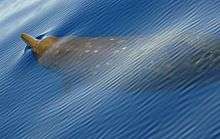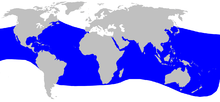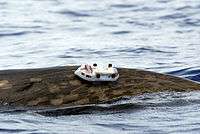Blainville's beaked whale
| Mesoplodon densirostris | |
|---|---|
 | |
 | |
| Size compared to an average human | |
| Scientific classification | |
| Kingdom: | Animalia |
| Phylum: | Chordata |
| Class: | Mammalia |
| Order: | Artiodactyla |
| Infraorder: | Cetacea |
| Family: | Ziphiidae |
| Subfamily: | Hyperoodontinae |
| Genus: | Mesoplodon |
| Species: | M. densirostris |
| Binomial name | |
| Mesoplodon densirostris Blainville, 1817 | |
 | |
| Blainville's beaked whale range | |
Blainville's beaked whale (Mesoplodon densirostris), or the dense-beaked whale, is the widest ranging mesoplodont whale and perhaps the most documented. The French zoologist Henri de Blainville first described the species in 1817 from a small piece of jaw — the heaviest bone he had ever come across — which resulted in the name densirostris (Latin for "dense beak").[2] Off the northeastern Bahamas, the animals are particularly well documented, and a photo identification project started sometime after 2002.
Taxonomy
Blainville named the species Delphinus densirostris, based on the description of a nine-inch piece of rostrum of unknown origin housed in the Paris Museum. The second specimen, a complete skull sent from the Seychelles by a M. Leduc in 1839, was named Ziphius seychellensis by the English zoologist John Edward Gray in 1846; the French scientist Paul Gervais later placed this specimen in the genus Dioplodon ("two-toothed").[3][4]
Description
The body of Blainville's beaked whale is robust, but also somewhat compressed laterally compared with other mesoplodonts. The males have a highly distinctive appearance, the jaws overarch the rostrum, like a handful of other species, but does it towards the beginning of the mandible and then sloped down into a moderately long beak. Before the jaw sloped down, a forward-facing, barnacle infested tooth is present. One of the more remarkable features of the whale is the extremely dense bones in the rostrum, which have a higher density and mechanical stiffness than any other bone yet measured.[5] At present, the function of these bones is unknown, as the surrounding fat and the brittleness of the bone make it unlikely to be used for fighting.[5] It has been suggested that it may play a role in echolocation or as ballast, but without sufficient behavioral observation, this cannot be confirmed.[5] The melon of the whale is flat and hardly noticeable. Coloration is dark blue/gray on top and lighter gray on the bottom, and the head is normally brownish. Males have scars and cookie cutter shark bites typical of the genus. Males reach at least 4.4 m (14 ft 5 in) and 800 kg (1,800 lb), whereas females reach at least 4.6 m (15') and 1 tonne (2200 pounds). Juveniles are 1.9 m (6 ft 3 in) long when born and weigh 60 kg (130 lb).
Population and distribution
This species of beaked whale is found in tropical and warm waters in all oceans, and has been known to range into very high latitudes. Strandings have occurred off Nova Scotia, Iceland, the British Isles, Japan, Rio Grande do Sul, South Africa, central Chile, Tasmania, and New Zealand. The most common observations take place off Hawaii, the Society Islands, and the Bahamas. The species does not migrate. It inhabits water 1600 to 3000 feet deep. Despite the relatively common nature of the whale, no population estimates are available.[6]
Behavior
The whales are seen in groups of three to seven individuals. Dives have been measured to at least 22 minutes. When the cetacean surfaces, it does so slowly and with little splashing, research has shown that these whales typically fall silent above 170 meters, probably in order to avoid Orcas from preying on them.[7]
It probably feeds mainly on squid; the stomach of one stranded individual contained only squid.[8]
Conservation

The beaked whale has occasionally been hunted, but has never been a specific target.[6] Blainville's beaked whale is covered by the Agreement on the Conservation of Small Cetaceans of the Baltic, North East Atlantic, Irish and North Seas (ASCOBANS)[9] and the Agreement on the Conservation of Cetaceans in the Black Sea, Mediterranean Sea and Contiguous Atlantic Area (ACCOBAMS).[10] The species is further included in the Memorandum of Understanding Concerning the Conservation of the Manatee and Small Cetaceans of Western Africa and Macaronesia (Western African Aquatic Mammals MoU)[11] and the Memorandum of Understanding for the Conservation of Cetaceans and Their Habitats in the Pacific Islands Region (Pacific Cetaceans MoU).[12]
Specimens
- MNZ MM002350, collected Tongoia Beach, North of Napier, Hawke's Bay, New Zealand, 1998
Gallery
-

Adult male (in the Bahamas)
-

Mouth of adult female
-

A cow-calf pair surfacing
References
- ↑ Taylor, B.L.; Baird, R.; Barlow, J.; Dawson, S.M.; Ford, J.; et al. (2008). "Mesoplodon densirostris". IUCN Red List of Threatened Species. Version 2009.1. International Union for Conservation of Nature. Retrieved 12 September 2009.
- ↑ Sharks and Whales (Carwardine et al. 2002), p. 357.
- ↑ Raven, Henry C. 1942. On the structure of Mesoplodon densirostris, a rare beaked whale. Bulletin of the American Museum of Natural History, Vol. LXXX, Art. II, pp. 23-50.
- ↑ True, F.W. 1910. An account of the beaked whales of the family Ziphiidae in the collection of the United States National Museum, with remarks on some specimens in other American museums. Washington: Government Printing Office.
- 1 2 3 Curry, J. (1999), "The design of mineralized hard tissues for their mechanical functions", Journal of experimental biology, 202: 3285–3294
- 1 2 "Office of Protected Resources: Blainville's Beaked Whale (Mesoplodon densirostris)". Office of Protected Resources. Retrieved March 21, 2010
- ↑ Walker, Matt (July 25, 2011). "Blainville's beaked whales enter stealth mode". BBC Nature. Retrieved July 25, 2011.
- ↑ MacDonald, David; Barret Priscilla (1993). Mammals of Britain & Europe. 1. London: HarperCollins. pp. 179–180. ISBN 0-00-219779-0.
- ↑ Official website of the Agreement on the Conservation of Small Cetaceans of the Baltic, North East Atlantic, Irish and North Seas
- ↑ Official website of the Agreement on the Conservation of Cetaceans in the Black Sea, Mediterranean Sea and Contiguous Atlantic Area
- ↑ Memorandum of Understanding Concerning the Conservation of the Manatee and Small Cetaceans of Western Africa and Macaronesia
- ↑ Official webpage of the Memorandum of Understanding for the Conservation of Cetaceans and Their Habitats in the Pacific Islands Region
- Encyclopedia of Marine Mammals. Edited by William F. Perrin, Bernd Wursig, and J.G.M Thewissen. Academic Press, 2002. ISBN 0-12-551340-2
- Sea Mammals of the World. Written by Randall R. Reeves, Brent S. Steward, Phillip J. Clapham, and James A. Owell. A & C Black, London, 2002. ISBN 0-7136-6334-0
- Possible functions of the Ultradense bone in the rostrum of Blainville's beaked whale (Mesoplodon densirostris). Written by Colin D. MacLeod. Canadian Journal of Zoology, 80(1): 178-184 (2002). Available: here
External links
| Wikimedia Commons has media related to Mesoplodon densirostris. |
- ARKive - images and movies of the Blainville's beaked whale (Mesoplodon densirostris)
- Factsheets - Blainville's Beaked Whale
- Cetaceans of the World
- CMS
- Hawaii's Beaked Whales
- Whale & Dolphin Conservation (WDC)
